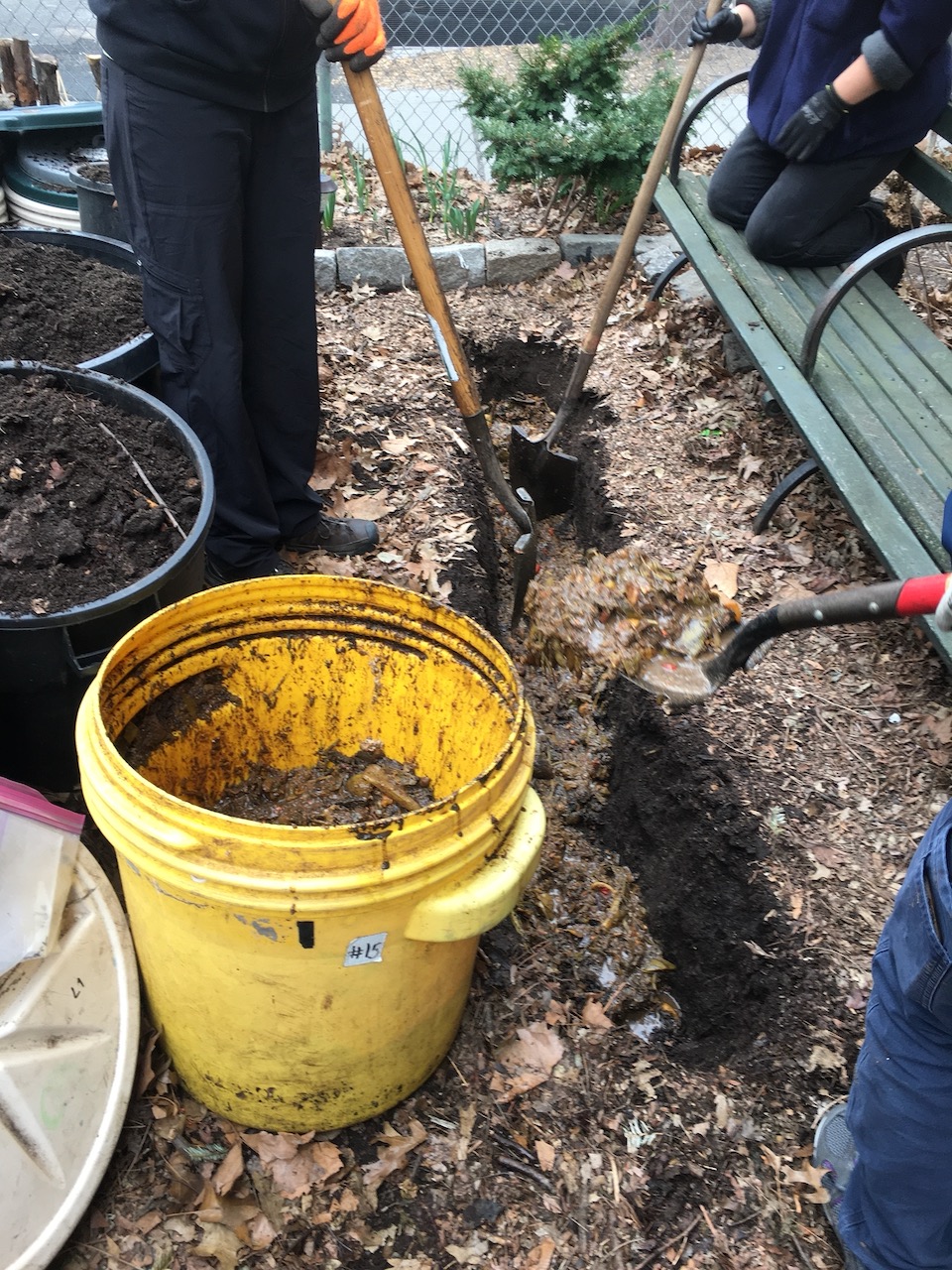Bokashi fermentation is an anaerobic process that breaks down food waste using Effective Microorganisms (EM). After fermentation, the bokashi food waste must be buried or trenched in soil to fully decompose and enrich the earth.
Bokashi food waste can be used as a soil amendment by trenching or burying it in soil, whether in a growing bed, landscape, for trees/orchards, or to amend soil for later harvest and use elsewhere.
This blog post provides a step-by-step guide on how to properly trench or bury bokashi food waste to maximize its benefits for your garden.
What is Bokashi Fermentation?
Bokashi is a fermentation method that processes food scraps in an airtight container using a bran or liquid inoculated with beneficial microorganisms. After 2–4 weeks of fermentation, the pre-processed bokashi food waste is ready to be buried in soil, where it completes decomposition and transforms into nutrient-rich humus. Trenching or burying is a critical step to integrate the fermented organic matter into the soil effectively.
bokashi food waste (or bokashi fermented food waste, or fermented food waste (FFW), i.e., “food waste fermented by the bokashi method”)
Prerequisites: bokashi sprinkle and/or bokashi spray, EM•1, bokashi food waste
Why Trench or Bury Bokashi Food Waste?
- Rapid Decomposition: Fermented bokashi food waste breaks down faster in soil compared to raw food scraps.
- Soil Enrichment: It adds organic matter and nutrients, improving soil health and fertility.
- Odor Control: Burying prevents odors and deters pests.
- Space Efficiency: Trenching is ideal for small gardens or urban settings with limited space.
Materials Needed
- Fermented bokashi food waste (from your bokashi bucket)
- Shovel or garden trowel
- Garden soil
- Optional: A designated trenching area or raised garden bed
- Gloves (optional, for hygiene)
Techniques Depending on Location and Purpose
- Burying or trenching in the soil ground
- Burying in raised beds or garden box
- Pocket feeding
- Bowl-trenching or surface-trenching
- In pots/planters
Purpose or Goal
- To grow plants
- If no plants are growing yet (e.g., off-season, post-harvest, pre-planting, soil prepping, or starting fresh), use the trench or bury technique.
- If plants are growing, use the pocket-feeding technique.
- For trees
- If the soil ground stretches beyond the tree canopy
- If the tree is either in a confined street tree pit or large pot/planter
- If an orchard
- To produce amended soil
- If in the ground
- If in a bed, box, or container
Step-by-Step Guide to Trenching Bokashi Food Waste
1. Choose the Right Location to Trench Bokashi Food Waste
Select a suitable spot in your garden or yard for trenching.
- Avoid areas near edible crops: Fermented bokashi food waste is acidic and may temporarily affect nearby plants.
- Pick well-draining soil: Ensure the area isn’t prone to waterlogging.
- Consider a fallow bed: A bed not currently used for planting is ideal, as the waste needs 2–4 weeks to fully decompose.
- For small spaces, use a large pot or container filled with soil.
2. Dig a Trench or Hole for The Bokashi Food Waste
- Depth: Dig a trench or hole about 8–12 inches (20–30 cm) deep to deter pests and allow proper decomposition.
- Size: The trench should accommodate the bokashi food waste with enough room to cover it completely with soil. Aim for 1 part waste to 2 parts soil cover.
3. Add the Bokashi Food Waste
- Empty the fermented bokashi food waste into the trench. Break up large clumps to aid decomposition.
- If the waste is very wet, mix in some dry soil to absorb excess moisture.
- Spread the waste evenly across the bottom of the trench.
4. Cover Bokashi Food Waste with Soil
- Cover the bokashi food waste with at least 6–8 inches (15–20 cm) of soil to prevent odors and discourage animals.
- Tamp down the soil lightly to compact it.
- If you are trenching in a garden bed, mark the area to prevent planting there for a few weeks.
5. Let The Bokashi Food Waste Decompose
- Allow the buried bokashi food waste to decompose for 2–4 weeks, depending on soil temperature and conditions. Warmer soils accelerate the process.
- The fermented organic matter will fully break down into humus, leaving no recognizable food scraps.
- After this period, the area can be planted.
6. Maintain the Area
- Avoid disturbing the trenched area during decomposition.
- If odors or animal activity occur, add more soil to cover the waste.
- Water the area lightly if the soil is very dry, as moisture aids decomposition.
Tips for Success
- Trench in rotation: For regular bokashi food waste, create multiple trenches in different garden areas to avoid overloading one spot.
- Test soil pH: Bokashi food waste can temporarily lower soil pH. Check the pH after decomposition and amend with lime if needed for sensitive plants.
- Combine with soil: If trenching space is limited, mix the fermented waste into a soil pile, ensuring it’s well-covered.
- Manage liquid: Drain excess liquid (bokashi tea) from the bucket before burying to prevent anaerobic pooling in the soil.
- Use in winter: In colder climates, trenching is still effective, but decomposition will be slower. Consider insulating the trench with mulch.
Common Mistakes to Avoid
- Burying too shallow: Waste buried less than 6 inches deep may attract pests or produce odors.
- Planting too soon: Planting in the trenched area before decomposition is complete can harm plants due to the waste’s acidity.
- Overloading one area: Burying too much bokashi food waste in a small space can slow decomposition and affect soil balance.
- Ignoring drainage: Poorly drained soil can cause waterlogging, leading to unpleasant smells.
Benefits of Bokashi Food Waste for Your Garden
Trenching bokashi food waste is a sustainable way to recycle kitchen scraps while enhancing your garden’s health. The process:
- Improves soil structure and water retention.
- Adds essential nutrients like nitrogen, phosphorus, and potassium.
- Encourages beneficial microbial activity in the soil.
- Reduces landfill waste and methane emissions.
Other Uses of Bokashi Food Waste
- As greens or feed in composting
- To feed Black Soldier Fly larvae
- This conversion process turns materials into a type of organic fertilizer* or soil amendment that can be applied topically (it is not a composting process but an in-vessel microbiological, chemical, and mechanical process).
- Large amounts of fermented food waste could be processed in a similar way by using machinery to dig massive trenches or pits, or the process could be done in a way similar to silage using bagging equipment for the fermentation stage and trenching in fields or in public areas like parks and golf courses.
* Unless the source and type of organic materials used are consistently predetermined, the NPK or fertilizing effect of this type of “organic fertilizer” is then also not consistent.
Experiments with Bokashi Food Waste
- In small pots (conversion-overwhelm effect)
- Measuring pH levels
- Plant growth comparisons
- Seed viability after fermentation (including weed seeds)
- Plant tolerance/stimulant or impediment
Conclusion
Trenching or burying bokashi food waste is a straightforward and effective way to complete the bokashi fermentation process. By following these steps, you can transform your kitchen scraps into a valuable resource for your garden, minimizing waste and supporting sustainable gardening practices. Whether you’re an urban gardener or have a large backyard, trenching bokashi food waste is a practical solution for soil enrichment. Start trenching your bokashi food waste today and watch your garden thrive!

